Delicious Taiwanese Hot Pot and Homemade Meatballs recipe is a family-favorite comfort food that we enjoy on a cold winter day. Hot pot is all about customization, so add your favorite ingredients to suit your tastes and mood!
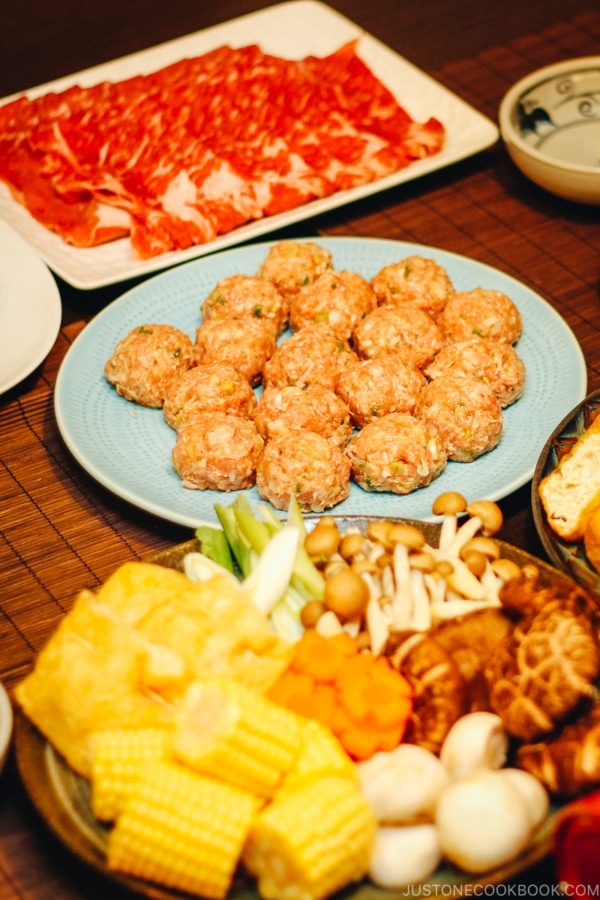
My kids love eating Shabu Shabu (Japanese hot pot) and Taiwanese hot pot. Japanese hot pot, we call “nabe,” typically has a basic soup base using kombu or dashi. On the other hand, Chinese hot pot is more creative, ranging from super spicy hot pot to just simple chicken broth.
We love hot pot because it not only tastes good, but it is also extremely simple to serve for a large party. Everyone cooks their food in a big shared pot. Today I will share our Taiwanese hot pot and meatball recipe that I make occasionally for hot pot, just to provide a variety of cooking ingredients besides the typical frozen options (dumplings, fish/shrimp ball, fish cake, etc). I hope you enjoy this recipe as much as our family does!
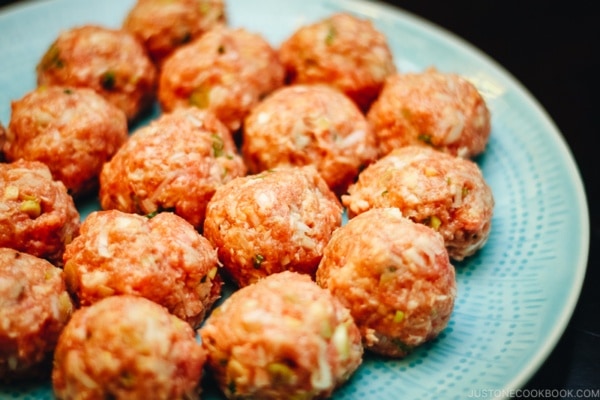
Wish to learn more about Japanese cooking? Sign up for our free newsletter to receive cooking tips & recipe updates! And stay in touch with me on Facebook, Pinterest, YouTube, and Instagram.
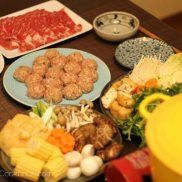
Taiwanese Hot Pot with Homemade Meatballs
Ingredients
For the Homemade Meatballs
- 1 lb ground pork
- 1 green onion/scallion (finely chopped)
- 1 Tokyo negi (naga negi; long green onion) (use only the white part; finely chopped)
- 1 Tbsp ginger (minced)
- 1 large egg yolk
For the Meatball Seasoning
- 1 Tbsp sake
- 1 Tbsp potato starch or cornstarch
- 1 Tbsp toasted sesame oil
- 1 tsp soy sauce
- 1½ tsp Diamond Crystal kosher salt
- freshly ground black pepper
For the Dipping Sauce (per person)
- 2 Tbsp Taiwanese BBQ Sauce (spicy or non-spicy Satay Sauce)
- 1 Tbsp soy sauce
- 1½ tsp toasted sesame oil
- 1 tsp rice vinegar (unseasoned)
- green onions/scallions (chopped)
- cilantro (coriander) (chopped)
For the Taiwanese Hot Pot Soup
- 4 cups chicken stock/broth
- 4 cups water
- 2 green onions/scallions (chopped into 2-inch, 5-cm pieces)
- 5 cloves garlic (sliced)
- 1 knob ginger (1 inch, 2.5 cm; sliced)
For the Hot Pot Ingredients (suggestions)
- homemade meatballs
- 1 lb thinly sliced beef (such as ribeye) (I get “shabu shabu“ beef from a Japanese market; you can follow my tutorial to thinly slice your own meat)
- dumpling (store-bought)
- fish balls (store-bought)
- shrimp
- napa cabbage
- shungiku (chrysanthemum greens)
- Tokyo negi (naga negi; long green onion) (you can substitute it with leek or green onions)
- carrots
- sweet corn
- enoki mushrooms
- shiitake mushrooms (discard the stem)
- maitake mushrooms
- button mushrooms
- 1 medium-firm tofu (momen dofu)
- aburaage (deep-fried tofu pouch) (or Chinese crispy fried tofu)
- Japanese rice cake (kiri mochi) (it‘s not Taiwanese, but it‘s my family‘s must-have hot pot item)
Instructions
To Make the Homemade Meatballs
- In a large bowl, combine 1 lb ground pork, 1 green onion/scallion (finely chopped), 1 Tokyo negi (naga negi; long green onion) (white part only; finely chopped), 1 Tbsp ginger (minced), 1 large egg yolk. Then, add the meatball seasonings: 1 Tbsp sake, 1 Tbsp potato starch or cornstarch, 1 Tbsp toasted sesame oil, 1 tsp soy sauce, 1½ tsp Diamond Crystal kosher salt, and freshly ground black pepper. Mix well with your hand.
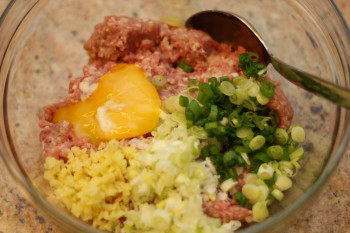
- Make small balls with your hands and refrigerate them in the refrigerator until you are ready to cook in the hot pot.
To Make the Dipping Sauce
- For each individual dipping bowl, add 2 Tbsp Taiwanese BBQ Sauce, 1 Tbsp soy sauce, 1½ tsp toasted sesame oil, 1 tsp rice vinegar (unseasoned), chopped green onions/scallions, and chopped cilantro (coriander).
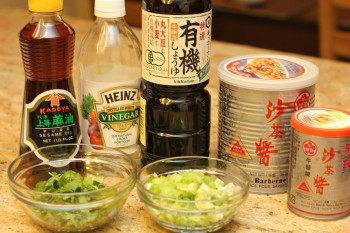
To Make the Taiwanese Hot pot
- Cut and gather all the ingredients on serving platters; please see my suggestions above.
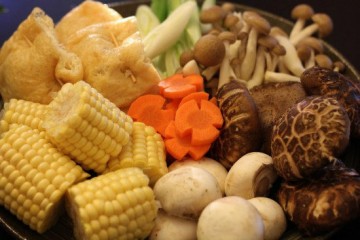
- My favorite hot pot ingredient is stuffed mochi in aburaage (fried tofu pouch). Cut an aburaage (deep-fried tofu pouch) in half and stuff a small piece of Japanese rice cake (kiri mochi) called kirimochi in it. You can use a toothpick to close the pocket.
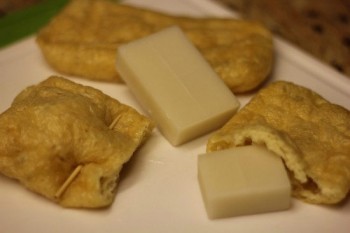
- Into a large pot, pour 4 cups chicken stock/broth. Add 4 cups water until the pot is half full. (You may not need all of the soup now, but keep them to add later.) Add the 2 green onions/scallions (chopped), 5 cloves garlic (sliced), and 1 knob ginger (sliced). Bring it to a boil.
- First, add some of the hard/dense vegetables such as sweet corn, Tokyo negi (naga negi; long green onion), carrots, the white part of napa cabbage (near the root), shungiku (chrysanthemum greens) stems, shiitake mushrooms, enoki mushrooms, frozen dumpling, etc. Cook, covered, until boiling.
- When the soup boils again, reduce the heat to a simmer. Most of the ingredients you put in earlier are not ready yet. Keep cooking until they are fully cooked (10–12 minutes). Meanwhile, add the homemade meatballs, mochi in aburaage, and soft/less dense ingredients like leafy greens, maitake mushrooms, fish balls, shrimp, and 1 medium-firm tofu (momen dofu). Keep simmering until they are warmed and cooked through.
- When you cook 1 lb thinly sliced beef (such as ribeye), hold a piece on the end with your chopsticks and dip it in the boiling broth. Gently shake the beef in the simmering broth for 20–30 seconds. The beef is now ready to consume. Try not to leave the meat in the broth for too long because it’ll get hard and won’t taste as good.
- Dip the ingredients in the sauce to enjoy!
To Store
- You can keep the leftovers in an airtight container and store in the refrigerator for up to 2 days.
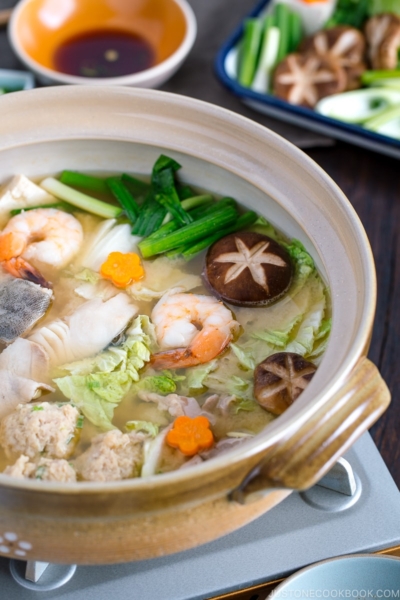
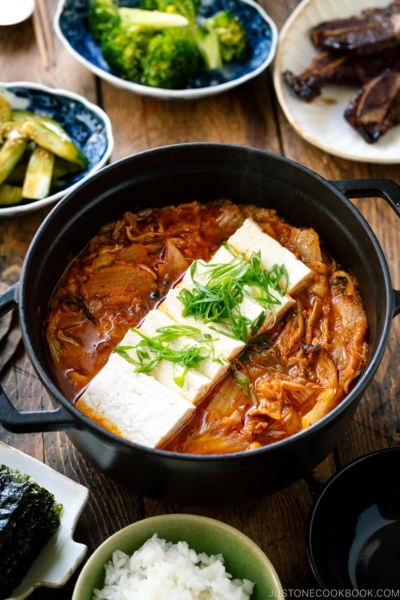
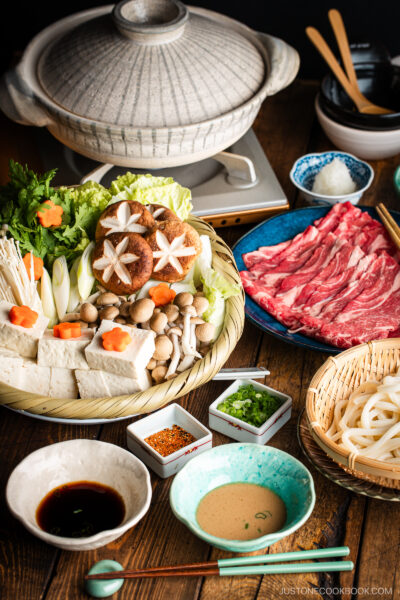





Hi Nami,
I used the meat ball recipe to make fishballs with fresh Cero (type of Mackerel) and it came out well. Do you have any recipe for fish balls?
Hi, Salina! Thank you for reading Nami’s post.
We currently do not have a fish ball or fish cake recipe. It’s already on our requested list, so we’re hoping to share the recipe sometime.🙂
Thank you for asking!
I was from Taiwan. This is my version of dipping sauce since childhood.
1) Taiwanese BBQ Sauce (Satay sauce, 沙茶醬)
2) Egg york.
3) Sauce Sauce paste ( Taiwanese sweet thick soy sauce, 醬油膏)
4) optional chopped green onion/garlic/red chillies)
This goes especially well with meet (pork/beef/lamb thin slices)
Please try it when you have the chance.
Enjoy it!
Hi Frank! Thank you for sharing! I’ll definitely try it next time! 😀
I am also from Taiwan and we do it almost the same but we add wasabi to ours, so good! Egg yolk, Taiwanese bbq sauce, wasabi and soy sauce and stir well. The best!!!
Hi Kim! Wasabi? WOW WOW WOW! That is so cool (but both Mr. JOC and I don’t really like wasabi – actually we only like freshly grated wasabi, which we enjoy in Japan). It must be a nice kick! 😀 We’re planning on Taiwanese hot pot soon. 😀
Hi Nami,
Can I also add noodles on this one?
Also, can you suggest a hotpot that I can get to use for both sukiyaki, shabu shanu and taiwanese hotpot?
By the way, i love your blog. I also go to your blog when i want to try something new. And it has always been a hit to my family.
Hi Aubrey! Sure, you can add noodles!
Hmmm traditional sukiyaki uses cast iron pot, but we can’t use it for shabu shabu or hot pot, so I’d say… a regular large pot is good.
Donabe, earthenware pot, is rare to use for sukiyaki, so if I have to use one pot, I’d probably use Le Creuset cast iron Dutch oven (enamel coated). The one you see in the picture here. It keeps the heat pretty well and it looks pretty.
However, it’s expensive and it’s not necessary too…. some hot pot that you can purchase in a Chinese grocery store does excellent job too. Good for shabu shabu and Taiwanese hot pot. It’s shallow pot, so you can see what’s inside. So I think this might be a good choice for all hot pot. 🙂
Thank you for reading my blog and trying out my recipes. I’m so happy to hear you enjoy cooking recipes from my blog. xoxo
Hi Nami,
May I know can I make big batch of meatballs and freeze them?
Hi Doreen! Yes, you can freeze, but you need a few steps.
1) Make meatballs and place them on a baking sheet or tray or some container with rim. Cover with plastic wrap.
2) Refrigerate for 30-60 minutes or so to make them rest.
3) Transfer the baking sheet/tray into a freezer. Freeze for 1-2 hours.
4) Once they are frozen, transfer to a ziploc bag or airtight container.
When you are ready to use, don’t thaw. Deep fry or cook while frozen. 🙂
Thanks a lot!
Hi Nami!
I found this wonderful, but not very well-commented recipe 😉 and I think I should try to cook it some day. I was always, always afraid of cooking nabe or shabu-shabu because I really don’t understand how to eat it properly.
For example, do you eat it at the table like fondue-style (on a small stove on the table) where the ingredients are cooking all the time? It’s great for meat, since the broth is hot all the time, but disastrous for vegetables, since they will be overcooked…
What are the typical ingredients for a Japanese nabe? Is it like sukiyaki with noodles and stuff? What is the difference between sukiyaki and nabe? Both are in some kind of broth… I just feel so totally lost 🙂
Hi Alina! Haha thank you! This is VERY VERY old post, so most people don’t notice it I think.
The way you describe is correct. We eat at the table. BUT don’t put all the ingredients. You only put ingredients that can be finished by the group of people you’re eating with (even 2 person). And when you take out all or most of ingredients, you’ll add new ingredients. Usually, root vegetables are hard to cook, so in between you would cook meat. I only put leafy vegetables that can be consumed by everyone… so we ask like “how much do you want to eat?” so you won’t end up with too much napa cabbage floating inside the pot.
Typical ingredients are what you find in my shabu shabu and sukiyaki recipe. These are TYPICAL and basic ingredients.
https://www.justonecookbook.com/shabu-shabu/
https://www.justonecookbook.com/sukiyaki/
Sukiyaki traditionally use a cast iron pot, while “nabe” implies “donabe” the earthenware pot (looks like this: https://www.justonecookbook.com/how-to-season-your-donabe/).
Sukiyaki uses soy sauce base sauce and it’s not really “broth”. It has some liquid in there, but not a lot of liquid to cook with. It’s much saltier so we eat it with raw egg (very safe, different from American eggs) to balance out the creaminess. It might sounds gross but a lot of people actually amazed how delicious it is.
Anyway, typical broth for nabe is kombu broth, but it can be Awase Dashi (kombu + katsuobushi/bonito flakes)… etc.
Well, it’s a lot to cover in one comment. Maybe you can check out my Hot Pot category and see each recipe. 🙂
https://www.justonecookbook.com/tags/hot-pot/
Nami, I am starting a Shabu (Chinese style) restaurant and I wanted to say thank you for all the great information. You saved me so much time. =)
Hi James! Aww glad to hear it. Good luck with your shabu restaurant business! 🙂